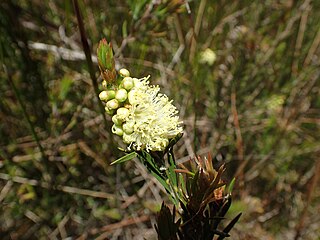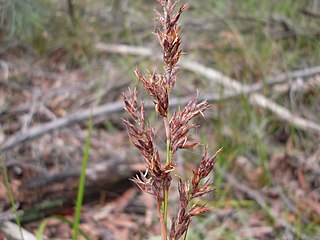
Lepidosperma gladiatum is commonly known as the coast sword-sedge or coastal sword-sedge. It is an evergreen species of sedge that is native to southern coastal areas of Australia. It was described by French botanist Jacques Labillardière in 1805. The Noongar name for the plant is kerbein.
Franz Wilhelm Sieber, was a botanist and collector who travelled to Europe, the Middle East, Southern Africa and Australia.

Lepidosperma is a genus of flowering plant of the family Cyperaceae. Most of the species are endemic to Australia, with others native to southern China, southeast Asia, New Guinea, New Caledonia and New Zealand.

Crocus sieberi, Sieber's crocus, also referred to as the Cretan crocus or snow crocus, is a plant of the genus Crocus in the family Iridaceae. A small, early blooming crocus, it easily naturalises, and is marked by a brilliant orange which is mostly confined to the stamens and style, fading through the bottom third of the tepal. It grows wild generally in the Balkans and Greece, especially in the island Crete. There are four subtypes: sieberi (Crete), atticus, nivalis and sublimis. Its cultivars are used as ornamental plants. Height: 3–4 inches (7.6–10.2 cm).

Hesperilla trimaculata, the three spot skipper, is a butterfly of the family Hesperiidae. It is found in Australia.

Eucalyptus sieberi, commonly known as the silvertop ash or black ash, is a species of medium-sized to tall tree that is endemic to south-eastern Australia. It has rough bark on the trunk and the base of larger branches, and smooth bark above. It has lance-shaped to curved adult leaves and flower buds in groups of seven to fifteen, which bear white flowers and barrel-shaped or conical fruit.

Melaleuca paludicola, commonly known as river bottlebrush, is a plant in the myrtle family Myrtaceae, and is endemic to eastern Australia. It is a shrub or small tree with flexible, often drooping branches, pinkish new growth and spikes of cream, pale yellow, or sometimes pink flowers in summer.

Cheilanthes sieberi is a small fern growing in many parts of Australia, New Zealand and nearby islands. Common names include poison rock fern and mulga fern.

Lepidosperma urophorum, the rapier saw sedge is a forest dwelling plant found in south eastern Australia. Often found on sandy soils near streams. It may grow to 1.5 metres high.

Lepidosperma laterale, commonly known as the variable swordsedge, is a plant found in south-eastern Australia, New Caledonia and New Zealand. It is often found on sandy soils or rocky areas in wooded areas.
Elachista velutina is a moth of the family Elachistidae that is found on the Fleurieu Peninsula in South Australia.

Lepidosperma concavum, commonly known as the sandhill sword-sedge, is a plant found in coastal regions of south-eastern and eastern Australia. It grows on sandy soils in woodland, forest and heathland.

Lepidosperma filiforme, also known as the common rapier-sedge, is a sedge that occurs in coastal regions of south-eastern Australia and New Zealand. Plants grow to between 0.3 and 1 metre high. The culms are smooth, rigid, terete and between 0.7 and 2 mm in diameter. The leaves are also terete and about 1 mm in diameter, with sheaths that are straw coloured or reddish.

Lepidosperma chinense, also known as the Chinese scaleseed sedge, is a plant widely distributed across Fujian, Guangdong, Guangxi, Hainan, Hunan, Zhejiang, Indonesia, Malaysia, Papua New Guinea, and Vietnam.
Verticordia sieberi is a flowering plant in the myrtle family, Myrtaceae and is endemic to the south-west of Western Australia. It is a shrub with one main stem, often compact but sometimes openly branched and with pink to pale purple flowers in summer and autumn.

Lepidosperma viscidum, the sticky saw sedge, is a grass like plant found in south eastern Australia. Usually seen in heath and woodland on sandy and rocky sites, it may grow to 60 centimetres high. This is one of the many plants first published by Robert Brown with the type known as "(M.) v.v." appearing in his Prodromus Florae Novae Hollandiae et Insulae Van Diemen in 1810. The specific epithet viscidum is derived from the Latin with a meaning of "sticky", which refers to the sticky resin from the base and margins of the leaves and stem margins. On drying, the resin turns a red colour.

Lepidosperma canescens is a sedge of the family Cyperaceae that is native to south-east South Australia and Victoria. There are no synonyms.

Lepidosperma amantiferrum is a sedge of the family Cyperaceae that is endemic to Western Australia. It has no synonyms.

Dillwynia sieberi, commonly known as Sieber's parrot-pea, is a species of flowering plant in the family Fabaceae and is endemic to eastern Australia. It is an erect shrub with rigid, needle-shaped, sharply-pointed leaves and yellow to yellow-orange flowers with reddish-brown markings.

Lepidosperma neesii is a grass-like plant found in south eastern Australia. Usually seen in heath and woodland on moist sites, it may grow to 80 centimetres tall. The specific epithet neesii honours the botanist Christian Gottfried Daniel Nees von Esenbeck.

















